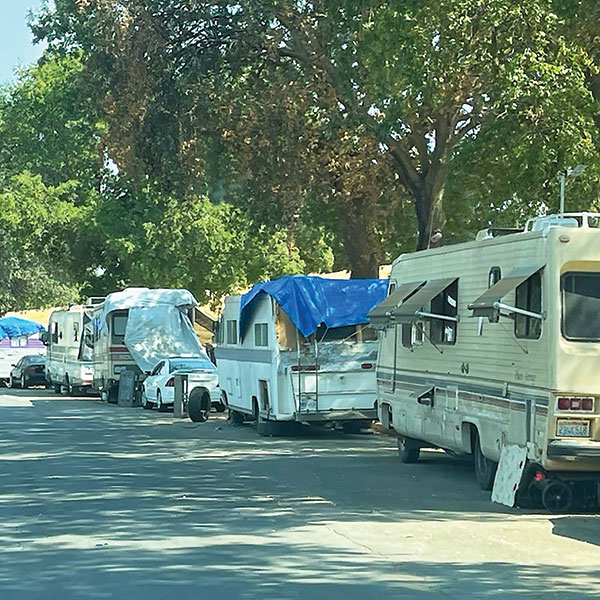I’m convinced most folks have no idea how much work happens behind the scenes with local government and leaders trying to resolve our homeless crisis.
Frustrated friends and neighbors tell me the city or county “does nothing” when an encampment gathers and grows. I decided to take a close look at two camps near my home and report on what’s really being done.
Commerce Circle is a commercial zone with offices and warehouses west of the Cal Expo Boulevard Costco. For two years, businesses on Commerce Circle endured some of the most extreme impacts of homelessness.

The street was an entrenched campground. People lived in tents and more than 160 vehicles. Crime and drug abuse thrived. Business employees and customers were assaulted. Property was stolen or destroyed.
“Assaults, flagrant drug use, a murder, vehicle thefts, prostitution, disposal of sewage in storm drains—threatening the American River—and decimation of our adjacent levee demanded that action be taken,” says Jeff Harris, the city councilmember who represented the neighborhood.
Finally, the city took action in December. Around 160 vehicles were first warned and then cited for illegal parking. Many moved. Others—burned or vacant—were towed.
“Relief was immediate,” Harris says. “The businesses that were struggling now have a chance at survival.”
The action prompted criticism about forcing homeless vehicles to move without a new destination. But Harris turned the criticism around—he’s worried about what happens to residents and businesses when homeless camps are ignored.
“With large, entrenched camps, taking an action like this gives immediate relief to an area beleaguered by homeless impacts,” he says. The vehicle camps might return, but in the meantime the city is working to identify appropriate sites for the campers.
“There is a balance needed to seek safety and good outcomes for both the unhoused and the housed,” Harris says. “As a representative, I will not turn my back on any of my constituents, regardless of their housing situation.”
He adds, “People often forget that businesses and homeowners for the most part pay the taxes that provide the funds to finance homeless shelters and housing opportunities. If we allow the homeless population to decimate businesses or neighborhoods, we will not be able to achieve good outcomes for anyone.”
Mayor Darrell Steinberg disagreed with Harris. Steinberg introduced a resolution that would prevent the city from clearing camps and towing vehicles unless alternative sites can be found.
“It may sound good on paper, but realistically we do not have spaces for the more than 3,000 camp vehicles parked unlawfully on our streets and may not ever have that capacity,” Harris says. The mayor’s resolution was defeated.
Another homeless encampment is near Fair Oaks Boulevard and Howe Avenue. The camp started with one tent about seven months ago and grew to more than 30 tents, with trash dumps and fires visible at night. A nearby medical office site on Scripps Drive was set on fire recently by homeless people.
The camp is on city property near the county line. Councilmember Eric Guerra, who represents the neighborhood, says, “We have been actively working in collaboration with Supervisor Rich Desmond to coordinate the effort of the city and county agencies to address the problem.”
The city has conducted outreach at the camp for about seven months, Guerra says, with 39 trash cleanups.
Guerra voted against Steinberg’s resolution to restrict future cleanups. The councilmember says, “We still continue to work on a collaborative response with our county counterparts to ensure a wholesome response, while pushing to prioritize shelter and bedding space proposed in District 6 through the Homelessness Master Sitting Plan.”
The situation at these two camps—plus hundreds of others in the city and county—is inhumane for poor souls living in horrendous conditions while waiting for housing. It’s also heartbreaking for neighbors impacted by crime, drugs, trash and disruption.
The work is not fast, easy or without huge legal, financial, political and practical hurdles. Guerra is ramping up a run for the state Assembly. Let’s hope Guerra is as effective as Harris at cleaning up his district’s Fair Oaks Boulevard encampment.
Harris faces constant criticism and sniping. Yet his hard work and perseverance should be appreciated for what it is—incrementally moving the city closer to its goal of clean, safe streets and housing for all.
Cecily Hastings can be reached at publisher@insidepublications.com. Follow us on Facebook and Instagram: @insidesacramento.
















